The Economic Forecast Council, 2003
Introduction
Prior to the annual budget, the Minister of Finance seeks
the advice of the Economic Forecast Council (the Council)
on the outlook for the provincial economy and presents their
forecasts with the budget. This consultation process is
laid out in the Budget Transparency and Accountability
Act.
The Minister met with the Council on December 9, 2002 to
discuss the economic outlook. Council members' forecasts
were made public at that time. The underlying forecast details
are summarized in the table at the end of the topic box.
Council members discussed their views on the provinceĺs
near-term economic outlook, as well as factors affecting
the provinceĺs medium-term outlook. This was followed by
a discussion of the impact of fiscal policy and other issues
facing the BritisháColumbia economy.
Overview
British Columbia outperformed the Council's earlier forecast
of 0.7áperácent for 2002, growing an estimated 1.9áperácent
last year. The stronger-than-expected growth reflected the
province's rapid turnaround early in 2002. The Council indicated
that the increased economic activity was mainly due to a
surge in home construction and sales, as well as other consumer
spending fuelled by federal and provincial tax cuts and
lower-than-expected interest rates.
The general view of the Council was that the British Columbia
economy would post stronger growth in 2003 and 2004 then
grow 3.1áperácent on average in the 2005 through 2007 period.
The Canadian economy was expected to continue to outpace
the U.S. economy in 2003 but stronger U.S. growth in 2004
would close the gap between the two countries. The discussion
focused on the strength of the recovery in the U.S., the
lack of job growth in the U.S. and implications for consumer
spending, as well as the risk of a "double dip" recession
in the U.S. The Japanese economy was not expected to improve.
International Outlook
Most Council members expected the economic recovery in
Canada, which began in early 2002, to continue. The Canadian
economy was forecast to outpace the U.S. economy in 2003.
Subsequently, stronger U.S. economic growth in 2004 through
2007 would result in the U.S. growing at a slightly faster
pace than Canada.
The recovery in the U.S. economy, which was weak during
2002, was expected to gain strength in 2003 and beyond.
In 2002, there had been a notable absence of business investment.
As a result, economic growth was mainly due to consumer
spending and residential investment. Changes in inventories
also contributed to growth.
The majority of Council members agreed that there is considerable
monetary stimulus in the U.S. economy to support a strong
recovery. With interest rates at 40-year lows, the interest
sensitive sectors of the economy, including housing and
consumer spending, would continue to grow.
However, some Council members expressed concern about the
risk of slower growth in the U.S. during 2003. In part,
this was attributed to a lack of job growth putting at risk
the ability of consumers to fuel further economic growth.
Recent stock market declines, high consumer debt levels
and lack of job growth could result in lower consumer spending
and reduce overall economic growth.
Forecasts for the U.S. economy had a wider range than those
for the Canadian economy in 2003, reflecting the divergent
views about the strength of the U.S. recovery. Overall,
the U.S. economy is forecast to grow on average 2.8áperácent
in 2003 and 3.7áperácent in 2004, before slowing to 3.3áperácent
during the 2005 to 2007 period.
Council members generally agreed that the Japanese economy
continues to face structural problems and is not expected
to improve substantially until these problems are addressed.
The Canadian Economy
Last year, the Canadian economy outpaced the U.S. economy
in terms of job creation and overall growth. Canadian consumer
spending reflected a greater degree of pent-up demand and
stronger job creation than south of the border. This broad-based
Canadian expansion was widely expected to continue in 2003.
Some members of the Council suggested that the slower U.S.
recovery would eventually have a dampening effect on economic
growth in Canada as demand for Canadian goods could slow.
The Canadian economy was forecast to grow 3.4áperácent
in 2003 and 3.6áperácent in 2004, before moderating to 3.1áperácent
on average in 2005 through 2007.
Although Council members do not forecast real GDP for Europe,
the Council discussed the European outlook. In general,
the outlook for the region was for sluggish growth. One
Council member noted that Europe was in need of labour market
changes to boost economic growth. Another noted that the
efforts by some European Union member countries to meet
the EU required fiscal targets could be a drag on economic
growth.
Financial Markets
In the U.S., the Federal Reserve Board was generally not
expected to begin raising interest rates until mid-2003.
Council opinions differed as to how fast interest rates
would rise. For example, those who expected slower economic
growth had interest rates staying lower for a longer period
than those who predicted stronger economic growth.
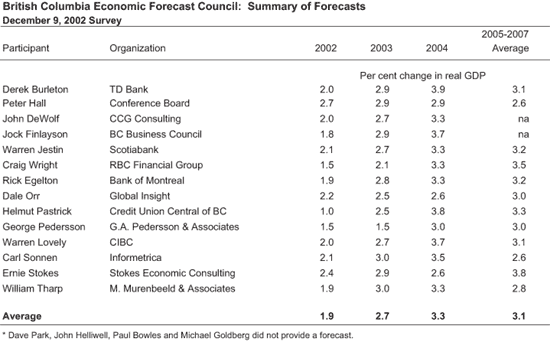
Most Council members agreed that interest rates in the
U.S. were low enough to support a relatively strong recovery
by 2004. The intended federal funds rate was projected to
be 1.9áperácent on average in 2003, rising to 3.5áperácent
in 2004 and 4.3áperácent in the longer term.
In Canada, the Bank of Canada's overnight target rate was
forecast to increase from 3.4áperácent in 2003 to 4.6áperácent
in 2004. Some Council members suggested interest rates in
Canada would rise sooner than in the U.S. given the stronger
recovery north of the border.
The positive interest rate spread between Canada and the
U.S. was expected to support a rising Canadian dollar. The
value of the Canadian dollar was forecast at 65.2ácents
US in 2003 and 66.7ácents US in 2004. For the 2005 to 2007
period, forecasts ranged from 62.0 to 73.8ácents US. The
widening range of forecasts in the longer term reflects
the divergent views among Council members on the ability
of the Canadian dollar to appreciate against a strong U.S.
currency.
British Columbia Forecast
On average, participants at the Economic Forecast Council
meeting expected B.C.'s economy to grow 2.7áperácent in
2003, 3.3áperácent in 2004 and 3.1áperácent per year in
2005 through 2007. Opinions for 2003 ranged from 1.5áperácent
to 3áperácent. Forecasts of growth in 2003 were highly concentrated
with 12 Council members predicting growth at or above 2.5áperácent.
There were two lower forecasts of 1.5áperácent and 2.1áperácent.
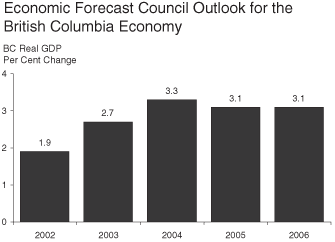
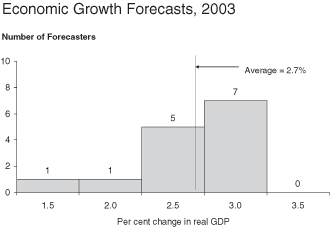
External Issues
Participants cited the softwood lumber dispute with the
U.S. as the biggest factor affecting the outlook for the
BC economy. Council members agreed that a resolution to
the softwood lumber dispute would benefit the province.
Two Council members noted that BritisháColumbia is uniquely
positioned to expand trade into the non-Japanese Asian markets,
particularly China.
Increasing geopolitical uncertainty, the risk of terrorist
attacks and a possible war with Iraq were mentioned as external
issues that could affect the BritisháColumbia economic outlook.
Sectoral Issues
The Council discussed recent developments in the domestic
economy then focused on the outlook for consumer spending,
housing and net in-migration.
Most Council members agreed that consumer spending in BritisháColumbia
was one of the main engines of growth in 2002. The consumer
sector was largely expected to continue to contribute to
overall economic growth in the forecast period. Retail sales
were predicted to increase 4.8áperácent in 2003, 5.5áperácent
in 2004 and 5.3áperácent per year in 2005 through 2007.
Retail sales growth was supported by low interest rates
in the short-term and gains in employment and incomes over
the medium to longer term.
Residential construction was generally forecast to grow
during the forecast period reflecting pent-up demand for
housing and relatively low interest rates.
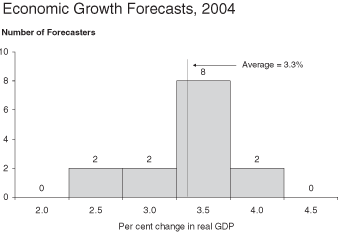
Some Council members expected continued high international
in-migration levels accompanied by a turnaround in net interprovincial
in-migration. The return to positive net inflows of people
from other provinces was due to improved employment prospects
during the next few years, as well as the establishment
of a more competitive tax environment. Others forecast a
continued exodus from BritisháColumbia to other provinces,
despite improved economic growth.
The divergent views were reflected in the wide range of
forecasts of net in-migration. Forecasts ranged from 13,000
to 40,500 people in 2003.
Several Council members noted an improved level of consumer
and business confidence in the province since the provincial
and federal government tax cuts in mid-2001, and that improved
business confidence was key to increasing business investment.
Council members also commented that the absence of settled
native land claims was a potential deterrent to investment
in land-intensive sectors of the provincial economy. In
particular, investments in mining may be held up because
of uncertain access to land.
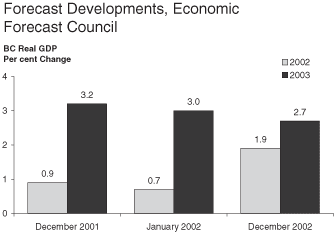
Government
Council members commented on the government's three-year
plan. Several stressed the importance of maintaining the
commitment to balance the budget beginning in 2004/05. Most
participants agreed that an increase in business investment
was needed to put the province on a faster growth path.
Some stressed that the existing tax cuts were necessary
to attract investment. As well, some Council members noted
that plans to continue with further business tax reductions
in Ontario and Alberta would put competitive pressure on
British Columbia over the next two to three years. Other
Council members noted that reduced government spending would
be a drag on overall economic growth.
Risks to the Outlook
The Council discussed the major risks to the outlook for
the British Columbia economy. On the upside, a possible
resolution of the softwood lumber agreement would improve
prospects for the BC economy. On the downside, a possible
war with Iraq, and a continuation of the jobless recovery
in the U.S. could jeopardize growth in BC. The Kyoto Protocol
was recognized as a potential risk to the outlook although
the implications were unclear.
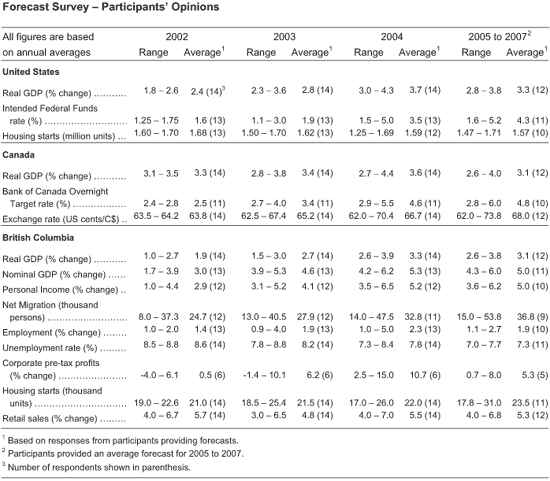
|
